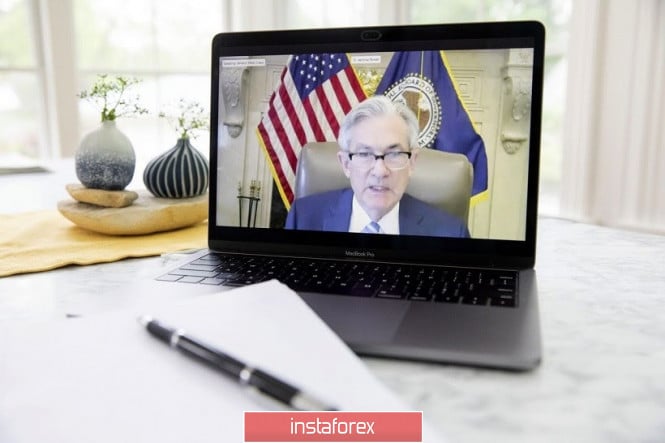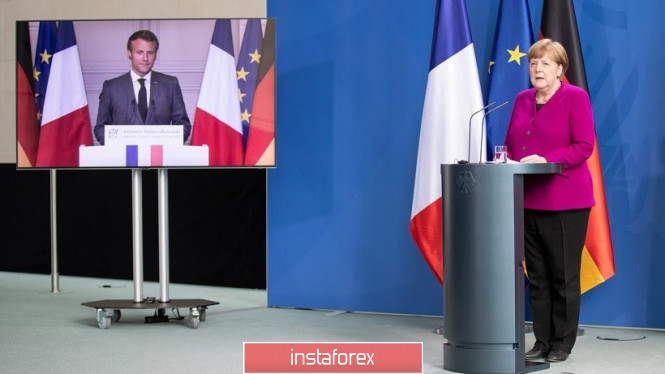The euro-dollar pair stayed within the ninth figure for the second day, although the bears made an attempt to counterattack yesterday, reducing the price to 1.0902. And yet, they failed to return the pair to its previous positions at the end of Tuesday, in the area of the price range of 1.0750-1.0890. This indicates that buyers are set for further price gains.
Yesterday, Federal Reserve Chairman Jerome Powell and US Treasury Secretary Steven Mnuchin addressed the Senate Banking Committee. The hearings were devoted to the fight against the negative consequences of the pandemic, the actions of the government and the Fed in the crisis. The rhetoric of the Fed chief made it possible for dollar bulls to stop the greenback's fall. At the same time, Powell was unable to turn the EUR/USD pair down: first, the theses he voiced were already familiar to the market, and secondly, the Fed chief was not so optimistic that the dollar felt confident in its abilities. By and large, traders were satisfied only by the fact that Powell did not raise the topic of negative rates. A few days before his speech to Congress, he already rejected this idea, calling on congressmen to simultaneously accept an additional package of anti-crisis assistance worth three trillion dollars. The house of representatives, controlled by Democrats, passed the bill – but Republicans and the White House criticized the document quite harshly. This means that the law will not be approved by the Senate, and, accordingly, will not be signed by Trump.

Against the background of such events, the market has raised concerns about the Fed's further actions. After rejecting the idea of negative rates, Powell added that the regulator has "enough options in its arsenal to respond." But yesterday, the Fed chief outlined his next steps rather vaguely. According to him, the central bank is now "considering ways to help an additional number of borrowers." At the same time, the amount of funds issued at the moment is, according to Powell, "quite moderate". However, the regulator is exploring the possibility of providing additional funds to states with relatively small populations.
In other words, the Fed chief made it clear that the central bank is not ready to take active actions to ease monetary policy in the near future, despite the decline in key macroeconomic indicators. This relatively passive position provided support for the dollar, which, paired with the euro, was able to strengthen to the bottom of the ninth figure. However, this fundamental factor did not enable the dollar bulls to return to their previous positions, that is, to the area of the eighth figure. By and large, Powell did not say anything new, and in contrast to his vague wording about the Fed's future actions, he made it quite clear that the US economy will recover longer than previously expected. In particular, it allowed for an increase in unemployment to 25%, a decline in GDP by 20%-30%, and a significant decrease in economic activity. At the same time, he repeated the thesis that the economy's recovery may require additional government spending in excess of the three trillion already approved by Congress. This remark returned the US currency to a depressed state, given the hopeless prospects of the above-mentioned anti-crisis bill.
Thus, Powell did not fundamentally change the balance of power in the market: the greenback was still very vulnerable, especially against the background of a general decline in anti-risk sentiment.
In turn, the European currency still "lives on hopes". Let me remind you that Angela Merkel and Emmanuel Macron issued a joint statement, which states the need to create a fund for economic recovery in the European Union. They plan to borrow 500 billion euros for it, which will be given to lenders within 20 years. All 27 EU member states must support this initiative for this plan to become a reality. Ursula von der Leyen, head of the European Commission, has already called Merkel's idea "constructive", promising to develop a detailed plan for its implementation until May 27. ECB Chairman Christine Lagarde also supported the announced plan.

However, some Northern European countries and Austria criticized Berlin's proposal. They emphasized that the funds under the proposal would be provided to the borrowing countries free of charge, and this would require increasing the contributions of member countries to the European budget. Representatives of the Netherlands, Sweden, Denmark and Austria were skeptical of this idea. Many EU countries have not yet announced their position on Merkel's plan, so the situation is in limbo. As some experts suggest, the EU leadership may "sweeten the pill" with the decision to lift restrictions on the budget debt of both EU member states and the European Commission. However, such proposals are still at the stage of backstage rumors. All this suggests that the future prospects of the euro will depend on the viability of Merkel's plan.
From a technical standpoint, bulls came close to the resistance level of 1.0950 – the lower border of the cloud Kumo coincident with the upper line of Bollinger Bands indicator on the daily chart, and it is the middle line of the Bollinger Bands indicator on the weekly chart. If buyers are above this target, they will be able to expect growth to the next resistance level, which corresponds to the 1.1060 level – this is the upper limit of the Kumo cloud on the daily chart, and the Kijun-sen line – on the weekly one. In other words, the pair's priority remains with the upward movement, but purchases can be considered when consolidating above 1.0950.
The material has been provided by InstaForex Company - www.instaforex.com